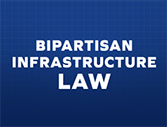Fact Sheet: Capital Investment Grants Program

BIPARTISAN INFRASTRUCTURE LAW FACT SHEET
CAPITAL INVESTMENT GRANTS PROGRAM
| Fiscal Year | 2022 (in millions) |
2023 (in millions) |
2024 (in millions) |
2025 (in millions) |
2026 (in millions) |
|---|---|---|---|---|---|
| Fixed Guideway Capital Investment Grant Program (Authorized Subject to Appropriation) |
$3,000 | $3,000 | $3,000 | $3,000 | $3,000 |
| Fixed Guideway Capital Investment Grant Program (Advanced Appropriations) |
$1,600 | $1,600 | $1,600 | $1,600 | $1,600 |
Program Purpose:
The Bipartisan Infrastructure Law, enacted as the Infrastructure Investment and Jobs Act, continues the discretionary Fixed Guideway Capital Investment Grants (CIG) program, which funds fixed guideway investments including new and expanded rapid rail, commuter rail, light rail, streetcars, bus rapid transit, and ferries, as well as corridor-based bus rapid transit investments that emulate the features of rail. There are three categories of eligible projects under the CIG program: New Starts, Small Starts, and Core Capacity.
Each type of CIG project has a unique set of requirements in the law, although many similarities exist among them. To be eligible to receive a CIG construction grant, all proposed projects must go through a multi-year, multi-step development process outlined in the law. FTA is required to evaluate and rate CIG projects on statutorily defined project justification and local financial commitment criteria that differ by project type, and a project must receive at least a “Medium” overall rating to advance through the steps in the process and receive a construction grant award.
Statutory References:
49 U.S.C. §5309; IIJA §30005
Eligible Recipients:
State and local government agencies, including transit agencies.
Eligible Activities:
- New Starts and Small Starts: Design and construction of new fixed-guideways or extensions to fixed guideways (projects that operate on a separate right-of-way exclusively for public transportation, or that include a rail or a catenary system).
- Small Starts: Design and construction of corridor-based bus rapid transit projects operating in mixed traffic that represent a substantial investment in the corridor and emulate the features of rail.
- Core Capacity: Design and construction of a corridor-based investment in an existing fixed guideway system that improves capacity not less than 10 percent in a corridor that is at capacity today or will be in 10 years. The project may not include elements designed to maintain a state of good repair.
- Joint intercity rail/public transportation project: Design and construction elements attributable to the public transportation portion of the total project cost based on projected use of the new segment or expanded capacity of the project corridor, not including elements designed to achieve a state of good repair.
What’s Changed?
- Revises the Small Starts and New Starts eligibility thresholds. Small Starts are now projects with a total estimated project cost of less than $400,000,000 and that are seeking CIG funding of less than $150,000,000. New Starts are projects with a total estimated project cost of $400,000,000 or more or that are seeking CIG funding of $150,000,000 or more.
- Revises Core Capacity project eligibility to corridors that are at capacity today or will be in 10 years, rather than in the 5-year timeframe under the FAST Act.
- Establishes a process for immediate and future bundling of projects to allow sponsors to move multiple projects through the CIG pipeline simultaneously. The new bundling eligibilities replace the prior “Program of Interrelated Projects” eligibility.
- Adds a requirement for the Secretary to determine that a project sponsor has made progress toward meeting the transit asset management performance targets required by 49 U.S.C. 5326(c)(2).
- Amends the “warrants” provisions for New Starts and Core Capacity projects to remove the requirement that the total estimated capital cost of the project must be under $100,000,000.
- Requires the Secretary to provide full and fair consideration to projects that seek an updated rating after a period of inactivity following an earlier rating and evaluation.
- Adds a requirement that FTA publish no less frequently than monthly a dashboard on its public website with information on each project seeking CIG funding.
- Before and After Study requirements (an analysis of predicted versus actual cost and ridership outcomes after a CIG project opens for service) were revised. The requirement that FTA report on those studies to Congress annually was also eliminated. Instead, the GAO, as part of its biennial review of the CIG program, will report to Congress on the differences between the predicted and actual outcomes for CIG projects.
- Revises the congressional notification timeframe required before a CIG construction grant can be awarded from 30 days to 15 days for New Starts and Core Capacity projects.
Federal Share:
The maximum CIG (Sec 5309) share varies by project type, with New Starts: 60 percent, Small Starts: 80 percent, and Core Capacity: 80 percent. Total federal funds for any project type may not exceed 80 percent.
